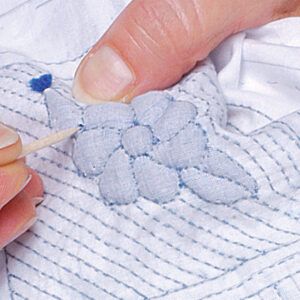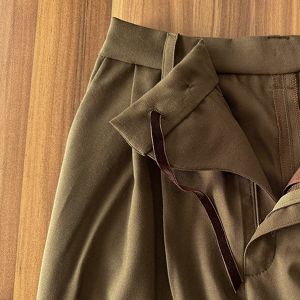I’ve been sewing with red cottons lately, and the dye has leeched into the white plastc bed of my machine. Is there an easy way to get rid of it? I don’t want to use anything that could scratch the plastic, but I’m sure there’s a way to do it. Any ideas would help. Thank you!
Nicole



























Replies
You could try toothpaste - the good old fashioned kind, not the gel. It gets the rust out of porcelain and does not scratch the surface.
I have found that sometimes, plain rubbing alcohol on a cotton ball will bring dyes up out of plastic
try some nail polish remover
I was going to suggest the alcohol also. One thing about nail polish remover it can cause a problem with the finish of the plastic surface.
Thank you for all of the suggestions. I was quite surprised that the cotton left such a mark! I'll try the alcohol first. I was also thinking that the Mr Clean magic eraser might work, but I don't know if it would get into the crevaces in the plastic (the bed has a tiny bit of texture). I think that the alcohol might be a better bet. Thanks again, everyone!
Nicole
*DON'T* use nail polish remover!!!!!! Acetone will damage most plastics!
There are acetone free nail polish removers.
Yes, there are acetone free nail-polish removers, but what a horrible mistake to use the wrong type on someone's precious sewing machine!!!! Far better to have a little red dye on the surface rather than a melted, pitted uneven sewing plate......
oh absolutely. I'm actually a bit surprised that it won't come off with a little soap, water and elbow grease actually. That must be some industrial strength dye which makes you wonder why it came off the fabric in the first place !
This is why I always pre-wash......
I'm having the same problem with some of my fabrics (mostly lycras). My beautiful machines are dyed black. I have tried rubbing alcohol, goo gone (which helped a little), and I believe it was 409 (?) my repair man said he tried last time one of my machines was being serviced. I have almost given up and just accepted the fact that my machines are stained. I can't prewash my fabrics because I do not sew for myself but for my business. Help!
I would say just be careful in what you use. My Pfaff machine is not the shiny type of plastic that my other machine is and the Pfaff seems to absorb the dye from all the fleece I have sewn in the past. I was successful in removing most of the dark dye stain only to accumulate more after sewing more dark fleece. I just noticed this week that where I had scrubbed on the top pf the accessory tray of the machine there are some small cracks. These are possibly from what ever solutions I had tried in scrubbing off the stain. I used vinegar and water and also some Oxy dish soap. I might have tried peroxide or alcohol I just don't remember. I even have some Spot Shot that I might have tried. It was several months ago that I scrubbed..but the cracks just appeared recently. I will pay more attention to what I use on my machine from now on.
I do like the results I get from Goo Gone. I've been using it for a while, not just on my machines, but on everything and I've never had any problems with it.
I was reading this discussion yesterday and this morning I found a helpful hint that is worth a try I think. It was how to remove tomato stains from plastic tubs and containers. They suggested two tablets of denture cleaner disolved in the container and allowed to sit for 20 minutes.
For the sewing machine bed, I would disolve the two tablets in the prescribed amount of water, then soak a towel or cloth large enough to absorb it and then just lay it over the bed for 20 minutes. I would saturate the towel to be plenty wet, but not drippy.
That sounds like a good idea. Everyone has been so helpful, but as of yet, the dye remains. It's turned pink though so the denture cleaner may help. Thank you!Nicole
Have you tried Clorox Clean Up?
I hate when this happens. I had it happen using some red fabric years ago, got most of it out, finally resorted to scouring powder, but when I went to sell that machine I bought a new accessory tray first since it wasn't all gone. I think the longer you wait the more likely it may be not to come out - we had one at the store that had been traded in that sewed beautifully but looked so horrible we didn't mind if we abused the surface just to see if we even could get the staining out - nothing worked.
Since that time with the red I wrap the free arm area and accessory tray if I keep it attached while sewing with clear plastic wrap, I cover everything except the metal throat plate. I had one customer bring in a machine that was red even on the "pillar' for lack of better word - the vertical part of the machine to right of machine bed, on the top of machine and the handwheel. I asked if the machine had been wrapped in the fabric and they tried to tell me it was from getting it on her hands then touching the machine but I don't buy that, at the least I think the fabric was thrown over it.
I was stunned recently when working on a black faux suede shirt and saw some slight discoloration on my accessory tray. That fabric had been prewashed and I'd never had a black croc onto the machine. I cleaned it immediately then wrapped it up. This'll be a pain if I have to do it with blacks as I sew so much that's black.
Next time rather than Saran wrap or such I'm going to try Glad's Press 'n Seal since it's tacky on one side and I hope will stick better.
Karen
I have differenet spots on my husky that are also dyed because of transfer from my hands.
Ok, I stand corrected! I guess the dye can transfer from fabric to hands to machine! I'd probably have been less untrusting except the customer had the machine in for the third time to have timing and some things reset and she and her husband were livid that a machine this new could have to have this many repairs... I politely asked her- several times - if she'd taken any of the free classes that came with it (no), had referred to the manual when she had a problem or when threading (she couldn't find it). I said let's make sure everything's being done correctly. On the very first step of threading she exclalimed "oh! Is THAT what that's for???!" and I realized her thread had never been threaded correctly, wasn't feeding correctly and was doing so very unevenly and when it wouldn't stitch right she'd force it over something.... I digress, but the tie in is that after all the complaining about the machine then finding out what was really going on I had a hard time believing the fabric dye on the hands story. Oh, and when she was picking the machine up from being serviced/fixed (free of course) they wanted to know if they'd cleaned it up and gotten that dye off of it too...
Karen
Karen I can certainly relate to your story of the lady with the red machine, and not properly threading it. I recently had a woman that brought her machines in and there were actually burn holes in the body of the machine. She said "I think that is where my iron fell on it." Can you believe it? Well the next question out of her mouth was do you loan machines? Guess what my answer was? As far as the stains you should be able to get them out with Goo Gone and the white side of the Stain Erasers like I was able to do. Good Luck.
I just read on another list that some have successfully used WD40 to remove pink and red stains from their machines.
Diane
Edited 3/18/2006 12:20 pm ET by diday
Well, I've tried rubbing alcohol, Goo Gone and Mr Clean Magic Eraser (with the blue side). Unfortunately my nail polish remover has acetone, and I doubt that my machine would benefit from the 'vitamine E' that the remover possesses. I called the store and was told that the rubbing alcohol would work. Perhaps if I drink some of the other kind I wouldn't be so worried about my machine bed!On to try different things. Thanks for everyone's help!Nicole
I agree that WD40 would be a good thing to try. Be sure and cover surfaces around it; this stuff leaves things slick! Also, have you tried Armor-All? Both of these products are safe solvents. Galey
Hi, I'm not sure how to get the dye off of a machine once it's there, but I read somewhere just recently about how to prevent it from happening in the first place. It said to use Glad Press 'n Seal on the surface of your machine. I have not personally tried this, but I have used the Press 'n Seal for other uses and really like it. It sticks well, but doesn't leave a residue.
I think with all the sewing I do I would get pretty annoyed with Glad Press n' Seal on my machine.
This post is archived.